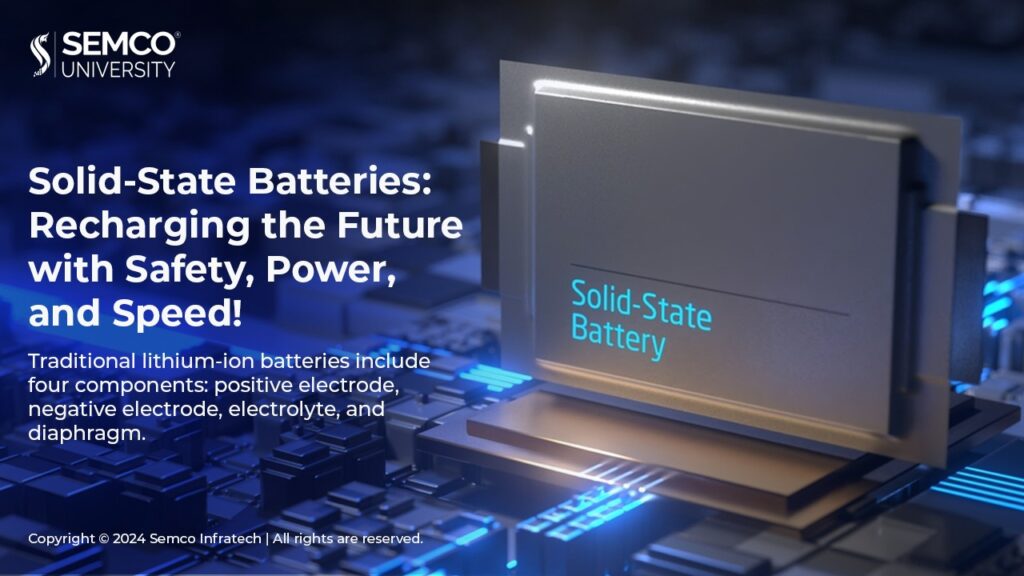I. Overview of solid-state batteries
Traditional lithium-ion batteries include four components: positive electrode, negative electrode, electrolyte, and diaphragm. Solid electrolyte is used in place of electrolytes in solid-state batteries. The primary distinction between conventional lithium-ion batteries and these ones is the transition of the electrolyte from a liquid to a solid state, which accounts for various attributes such as safety and high energy density.
There are various battery systems that fall under the category of solid-state batteries, including oxide, sulfide, polymer, and thin-film batteries.
II. Solid-state battery production process
The front-stage process of solid-state batteries is essentially the same as that of liquid-state lithium-ion batteries when compared to conventional liquid-state batteries. Solid-state batteries do not require liquid injection; instead, they require sintered or pressurized conditions during the middle and post-stage processes.
The electrolyte film-forming process is a crucial step in the entire solid-state battery manufacturing process. The solid electrolyte film’s thickness and ion conductivity will be impacted by various processes. An excessively thick solid electrolyte film will increase the battery’s internal resistance while lowering the mass and volume energy densities of the entire solid battery. On the contrary, the mechanical properties of the solid electrolyte film will deteriorate if it is too thin, which may cause a short circuit.

The electrolyte film-forming process, which is the fundamental step in solid-state batteries, is split into two types: wet and dry. Solid electrolyte films can also be created by vacuum sputtering, chemical vapor deposition, physical vapor deposition, and electrochemical vapor deposition in addition to the two wet and dry methods. However, only thin-film solid-state batteries can use the gas phase method due to its relatively high preparation cost.
Comparing the wet and dry methods used in the manufacture of solid-state batteries.
1) Solid-state batteries suffer from high internal resistance, poor cycle and magnification performance, and solid-solid-solid interface contact issues.
2) The sulfide solid electrolyte is demanding in the production environment and requires oxygen and water to be isolated, making the processing process challenging. In addition, it uses other production techniques, such as thin film deposition, that are wholly unrelated to those used in liquid lithium batteries today. The problem of mass production technology remains unsolved.
3) High production costs: The International New Energy Network reports that the cost of manufacturing and producing solid-state batteries is over 50%, compared to 20%–30% for liquid lithium-ion batteries. production process for solid-state batteries.
The manufacturing process for solid-state batteries requires advancements in the fields of electrolytes, interface engineering, packaging, and electrodes. An essential component of solid-state battery engineering and commercial application is process optimization and improvement.
III. The path of solid-state battery technology
Higher and higher standards have been placed on the lithium battery industry in recent years due to ongoing innovation in the downstream application field. Lithium battery technology has also been continuously improved in order to achieve higher energy and safety levels. Based on the trajectory of lithium battery technology development, liquid lithium batteries have gradually reached their limit in terms of energy density; therefore, solid lithium batteries will be the only viable option for further advancements in lithium battery technology.
Technical route: mixing of solids and liquids to the gradual development of all-solid states, with multiple parallel routes.
Solid-state batteries progress progressively from solid-liquid hybrid batteries to all-solid-state batteries in terms of technology. To balance out its advantages, the solid-state battery system currently includes some liquid electrolytes. Liquids will gradually disappear from mixed solid-liquid batteries and transition to liquid-free all-solid batteries as technology advances.
Since each of the three main systems has pros and cons of its own, it will be challenging to quickly promote all-solid-state lithium batteries on a large scale.
There are still technical differences between the three types of solid electrolytes: polymers, oxides and sulfides, and the three systems have their own advantages:
1) The first solid electrolyte to be used is polymer, however it has fatal issues with low conductivity and low energy density.
2) Oxide solid electrolyte performs well overall. Small batches of LiPON thin-film all-solid-state batteries have been manufactured.
3) Sulfide solid electrolyte has the highest conductivity, the highest research difficulty, and great development potential. Non-thin film has attempted to enter the consumer electronics market, but the cost is too high. One of the main issues is how to maintain high stability.
IV. Enterprise layout
Liquid lithium batteries and the solid-state battery industry chain are essentially the same. The primary distinction between the two is that while the positive electrode is nearly identical, the negative electrode’s materials and upstream and middle electrolytes differ. Should it fully mature into an all-solid battery, the diaphragm shall be substituted in its entirety. Emerging industries like energy storage, new energy vehicles, and consumer electronics make up the majority of the downstream application fields.
_____________________________________________________________________
About Semco – Semco University is an educational website that is catering to the needs of students and researchers. Offering information on Lithium-ion batteries. The resources and content are compiled from various sources including manufacturers, test labs, crowdsourcing, etc. Our motto is to provide a viable resource for companies, students, and enthusiasts interested in participating in the Li-ion Battery industry. Our initiative is to make people aware of the benefits, and opportunities of the revolutionary Lithium Batteries for multiple applications.
For More Updates Follow Us
WhatsApp – Facebook – Instagram – Twitter – LinkedIn – YouTube

